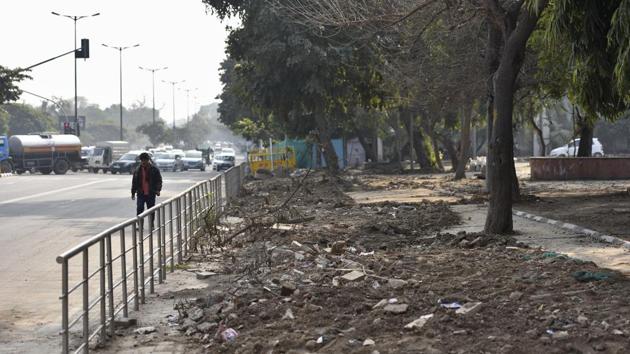Wanted in Delhi: Safe, walkable pavements
Many stretches in Delhi are built either too high or too narrow forcing pedestrians to walk on the road. The elderly and the disabled avoid them altogether.
What works best in the best cities in the world is walkability, wrote Jeff Speck in his book Walkable City.

Delhi, which has multiple problems with its pedestrian infrastructure, would not qualify to be in that league.
It is not that the National Capital lacks investment in walking infrastructure. Over the decades, we have built as many as 80 foot-over bridges, each worth a couple of crores. Last year, Delhi got its first skywalk – a ₹55-crore pedestrian bridge that runs 600-metres over four arterial roads at the busy ITO-Pragati Maidan junction.
However, overhead bridges — including the new skywalk — remains the most under-used civic infrastructure because pedestrians prefer ground access. But barring the VIP areas and some key arterial roads, agencies have failed to provide uninterrupted grade-level walk paths.
Shoring up walking spaces does not cost a bomb. It requires some basic masonry and housekeeping. A footpath, a walkway for pedestrians in a built-up area, is among the most basic civil construction works. Yet, we get it wrong in our cities. Many stretches in Delhi are built either too high or too narrow forcing pedestrians to walk on the road. The elderly and the disabled avoid them altogether.
In 2013, researchers from Central Road Research Institute surveyed 14km of road length in Delhi. On 27% of the stretch, pavements were missing. Only 55% of these pavement stretches had acceptable height and a pedestrian had to go up and down 28 times every 100 meters while walking on them.
When the pedestrians were asked why, despite heavy traffic, they walked on the road (left half of the motorized path), 60% said the surface of the footpath was not good, 49% said it was not continuous and 33% said it was too high.
The study, which was conducted on a “typical working day”, found that 26% of the footpath had obstructions such as garbage dumps and potholes. At least 36% of the pavement was taken up by parked vehicles and hawkers and 5% had toilets, street signs, electricity poles etc. Not much has changed in six years since the study, HT correspondents found while reporting for the ongoing series on the “Right to Walk”.
Many of these problems are a result of poor upkeep and lack of enforcement. The PWD, which maintains all arterial roads in Delhi, outsources maintenance through tendering, which is a time-consuming process. As small repair jobs are not profitable for contractors, many of them wait for larger stretches to fall apart before they start the work, says an official who has knowledge of these procedures.
Delhi’s structural problems also come in the way, he says. The drains and sewer lines under the pavement often leak, backflow or hit dead-ends, damaging the surface. With multiple agencies controlling underground pipes, it is difficult to fix responsibility.
The frequent digging of roads and pavements to lay phone and power cables, sewerage, water and gas pipelines can be prevented if authorities lay permanent utility tunnels across Delhi. Dug up pavements are not only a walking hazard, the unending road-cutting and repairs also damage the original design, dimensions and slopes of footpaths for good.
Much of the pavement space is devoured by encroachers or illegally parked vehicles. Two-wheeler riders taking short-cuts by climbing pavements is common while in many places pavements are broken to create slopes so cars can be parked on them. While hawkers need to be streamlined, the agencies must stop building utilities such as toilets and power transformers on precious walking space.
Over the years, our governments have focussed only on building expensive roads, flyovers and bridges to facilitate faster movement of vehicles while ignoring the majority of pedestrians who, as Danish urbanist Jan Gehl says, make modest demands and do not crowd the city.
Gehl estimated that two 3.5-metre wide sidewalks or a 7-metre wide pedestrian street can handle 20,000 people per hour. In comparison, a two-lane, two-way street can take 1,000-2,000 cars per hour.
If Delhi could assign even half of this space to pavements — which the guidelines anyway mandate — it could make mobility easy for the vast majority of city dwellers who still mostly walk to conduct their lives.
A vehicle-choked, polluted city such as Delhi must encourage pedestrians. Providing safe walkable pavements is the very first step in that direction.




